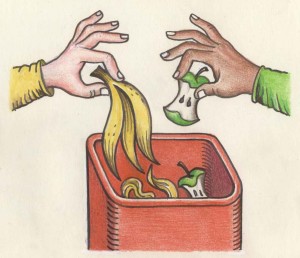Step-by-step guide to setting up a composting system at school
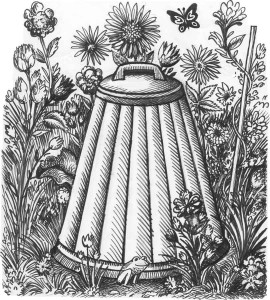 Composting garden weeds and waste
Composting garden weeds and waste
If you are not composting anything at all, you can easily start up a garden waste composting area. Have a look at the garden waste composting page to find out more about how to do this, and contact us to arrange a visit. Please note we now have to charge for school visits.
If you would like to start composting food waste, it is worth starting with raw food waste such as fruit peelings. Once you are confident with composting raw food, you can start on cooked food waste such as lunch-time plate scrapings. For composting any cooked food it is important to make sure you have the right equipment and mixture of materials. The Composting at School: a practical guide gives everything you could want to know about composting in school from the legislation to the practicalities. Here is a step-by-step process to setting up your school food waste composting:
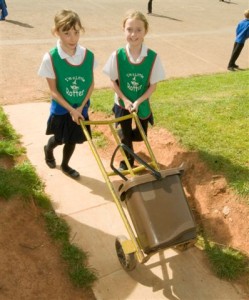 1. Get people on-board: Composting is simple, but it does need people to help it work – to collect the caddies and empty them into the composters, to make sure there is the right balance of wet and dry materials, and to use the compost. It works best when people at the school understand why it is important (even if they aren’t all doing the composting). This includes the head teacher, teaching staff, TA’s, grounds staff, pupils and parents. The DCCN schools composting advisors can help to demonstrate the many benefits of composting, and answer questions about it.
1. Get people on-board: Composting is simple, but it does need people to help it work – to collect the caddies and empty them into the composters, to make sure there is the right balance of wet and dry materials, and to use the compost. It works best when people at the school understand why it is important (even if they aren’t all doing the composting). This includes the head teacher, teaching staff, TA’s, grounds staff, pupils and parents. The DCCN schools composting advisors can help to demonstrate the many benefits of composting, and answer questions about it.
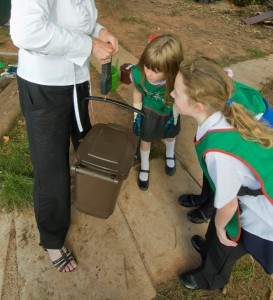 2. Do a food waste audit: This is a way of finding out how much raw and cooked food waste your school generates. It’s important information to help us find out if food waste can be reduced and to work out the type of composting equipment you will need. This involves collecting and weighing your food waste every day for 5 days and recording the results in spreadsheet. Resource Futures offer a fantastic one day whole school waste audit workshop which is a great way to start off.
2. Do a food waste audit: This is a way of finding out how much raw and cooked food waste your school generates. It’s important information to help us find out if food waste can be reduced and to work out the type of composting equipment you will need. This involves collecting and weighing your food waste every day for 5 days and recording the results in spreadsheet. Resource Futures offer a fantastic one day whole school waste audit workshop which is a great way to start off.
3. Reduce your food waste: Reducing any food that doesn’t need to be wasted is the first priority before you start to compost. WRAP have produced some excellent guides for reducing food waste at school:
Reducing food waste in schools
Improving the familiarity and appreciation of school meals
Improving the dining experience
4. Have a visit from one of the DCCN schools composting team and a skills-share visit: We can visit your school, talk through the waste audit results, have a look around your school grounds, find out who might be involved in it, and talk through the options of composting systems that could work for you.
We can also help you to arrange a skills-share visit to a nearby school that is already composting to find out how it works, learn from them and share ideas.
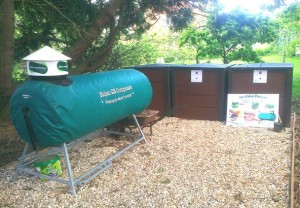 5. Fundraise for the equipment and other resources needed: To compost food waste this will usually include buying some specialist food waste composting equipment.
5. Fundraise for the equipment and other resources needed: To compost food waste this will usually include buying some specialist food waste composting equipment.
You may also need other resources such as wood chip/ sawdust to mix with the food waste, wheelbarrows and gloves. Many schools get these items donated by asking local parents or companies.
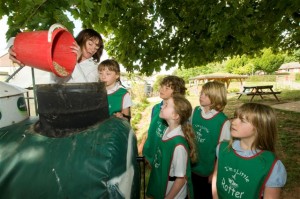 6. Set up the system, tell everyone about it and start composting: Once you have the equipment we can help to put it together if needed, and run an assembly to tell the whole school about your new composting system, how it works and what everyone can do to help. We can also run a training session with any staff or pupils who are going to be looking after the composters so they know all about how it works.
6. Set up the system, tell everyone about it and start composting: Once you have the equipment we can help to put it together if needed, and run an assembly to tell the whole school about your new composting system, how it works and what everyone can do to help. We can also run a training session with any staff or pupils who are going to be looking after the composters so they know all about how it works.
You will now be ready to start composting!
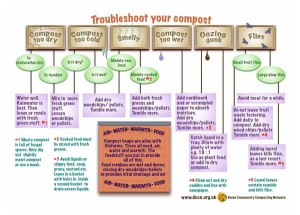 7. Maintaining and trouble-shooting: Now it is just a case of looking after the compost and the creatures so they keep producing wonderful compost for you to use in school. It often takes a month or two to get to know your compost system and sometimes, if something changes such as the main compost person or the quantity of cooked food waste, the compost can change. The troubleshooting guides for composting raw food waste and composting raw and cooked food waste outline what to do if the compost becomes smelly, cold or has flies. The DCCN schools composting team are always happy to visit to help bring your compost back to health, train up new composting staff and pupils, and run workshops for pupils. The school support page has more details of what we can do.
7. Maintaining and trouble-shooting: Now it is just a case of looking after the compost and the creatures so they keep producing wonderful compost for you to use in school. It often takes a month or two to get to know your compost system and sometimes, if something changes such as the main compost person or the quantity of cooked food waste, the compost can change. The troubleshooting guides for composting raw food waste and composting raw and cooked food waste outline what to do if the compost becomes smelly, cold or has flies. The DCCN schools composting team are always happy to visit to help bring your compost back to health, train up new composting staff and pupils, and run workshops for pupils. The school support page has more details of what we can do.
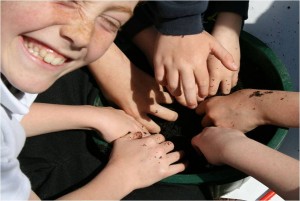 8. Use the compost as a learning and teaching resource: Compost is a fantastic learning resource, with opportunities to look at life-cycles, soil, mini-beasts, gardening, food, waste and poetry, as a start! There are plenty of resources to help you integrate compost and gardening into your teaching. Visit the compost teaching resources page to find out more.
8. Use the compost as a learning and teaching resource: Compost is a fantastic learning resource, with opportunities to look at life-cycles, soil, mini-beasts, gardening, food, waste and poetry, as a start! There are plenty of resources to help you integrate compost and gardening into your teaching. Visit the compost teaching resources page to find out more.
